|
Salmon Life Cycle
It is a difficult journey from egg to spawning adult. Only
about two percent of all salmon hatched will live to adulthood. There are
many natural predators of salmon - birds, fish, marine mammals, and disease.
Human-made obstacles include harvesting, rive blockages, pollution, and poor
habitat management.
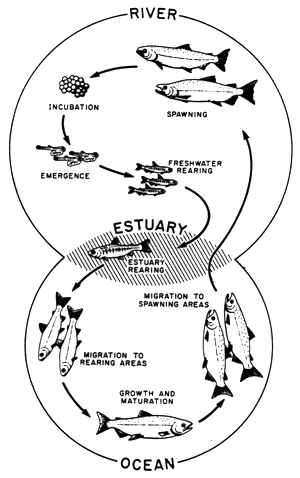
Eggs
The life cycle of a salmon begins as the female salmon chooses a site, digs a nest, or redd, with her
tail, and deposits her eggs. One or more males fertilize the eggs. Each nest
contains between 500 and 1200 eggs. About 20 out of 100 eggs laid may survive
to become fry. |
 |
Alevin
As
the eggs hatch, tiny alevins emerge, nestled in gravel and living on the nutritious
yolk "pot belly" on their undersides. The alevin cannot swim, but
only swish their tail to move around slightly in the gravel. While they have
a yolk sac, alevins do not need to eat. Once the yolk sac is gone, they must
find food quickly or they will starve. |
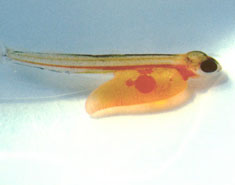 |
Fry
When juvenile salmon or fry emerge from the redd, they must find food immediately. Most feed on insects as they grow. The length salmon stay in the fry stage can be very different among various species. Chinook or King salmon immediately start heading for salt water. Coho or silver salmon will remain in their home stream for over a year before starting to swim down stream to find their way to the ocean. Some salmon will remain up to 3 years in the fresh water before heading to the ocean |
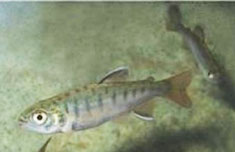 |
Smolt
Saltwater meets freshwater in estuaries, making a mix called "brackish"
water. When fry enter estuaries, they begin to adapt to saltwater, a process
called "smoltification." This major change causes young salmon to
become less active and more vulnerable to predators such as birds and larger
fish. To survive, young salmon must find places to hide and feed. Ocean-bound
young salmon may spend days or months in estuaries and nearshore waters as
they adjust to saltwater and grow, getting ready for an ocean journey.
Salmon are in the smolt stage when they start to swim to salt water. Some
are two years old and over 5 inches long. Smolts have a shiny, silver back.
Only a small percentage of the original salmon actually reach the ocean. |
 |
Adult Salmon
When the salmon reach the ocean they are considered to be adult salmon. They
will stay in the ocean from six months to five years. They will feed mostly
on shrimp, squid, and small fish. Adult salmon may travel thousands of miles
from the stream they were born in. When they are fully mature they return
to their home stream to spawn. Many scientists believe they migrate using
the magnetic field of the earth. They find their home stream by its particular
smell. |
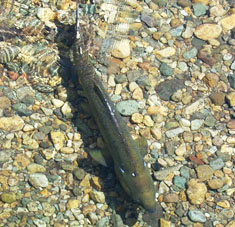 |
Spawner
When salmon enter enter freshwater to spawn, they stop eating. They lose their
shiny, silvery colors; males may take on bright body colors, a hooked nose,
and large teeth. Females may develop darker colors. Some species, such as
steelhead may spawn more than once. Most salmon species die within one week
of spawning. The dead salmon are not wasted. Their decomposing bodies add
important nutrients to the stream or river. Dead and decaying salmon also
provide food for a wide range of wildlife including bald eagles, bear, mink,
and river otter. |
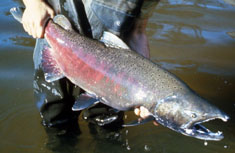 |
Salmon life cycle images courtesy of:
Back to Salmonid Information Page
Please contact us for more info.
|
